|
MUSIC ZONE
Saurabh & Gaurav
ALBUM
of the month
Fresh, evolved and
distinctive pop album
Todd Terje ó Itís
Album Time (Olsen Records)
 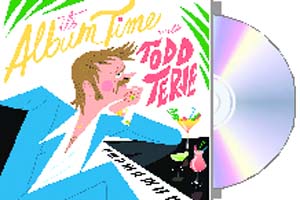 Norwegian producer-DJ
Todd Terje has built his reputation crafting successful disco-leaning
remixes and stand-alone dance epics over the past 10 years. Recorded
over a three-year period spanning 2012-14, Itís Album Time
contains a few cuts you may be familiar with already. The recordís
brief opener, Intro, with its escalating suspense and the
growingly loud "Itís Album Time," is a fantastic
burst of energy. The showpiece of the album is a cover of Robert
Palmerís Johnny & Mary. This low-tempo version takes a new wave
classic and transmutes it into 1980s electronica featuring vocals of
Bryan Ferry. The first half of the record ranges from the piano chords
and mystical filmic qualities of Leisure Suit Preben to the
bass-filled Preben Goes to Acapulco to the Latin American-infused
claps of Svensk SŚs. All the while, club-ready deep disco tracks
like, Strandbar and Delorean Dynamite, demonstrate Terjeís fluent
understanding of how musical elements work together. The album ends
back on the dance floor with the essential Inspector Norse, the
perfect disco closer for his revue. Terjeís sound is very much
rooted in the stylish space disco sound of Giorgio Moroder and here he
teases his slinky disco sounds and mesmerising beats in all possible
directions. Norwegian producer-DJ
Todd Terje has built his reputation crafting successful disco-leaning
remixes and stand-alone dance epics over the past 10 years. Recorded
over a three-year period spanning 2012-14, Itís Album Time
contains a few cuts you may be familiar with already. The recordís
brief opener, Intro, with its escalating suspense and the
growingly loud "Itís Album Time," is a fantastic
burst of energy. The showpiece of the album is a cover of Robert
Palmerís Johnny & Mary. This low-tempo version takes a new wave
classic and transmutes it into 1980s electronica featuring vocals of
Bryan Ferry. The first half of the record ranges from the piano chords
and mystical filmic qualities of Leisure Suit Preben to the
bass-filled Preben Goes to Acapulco to the Latin American-infused
claps of Svensk SŚs. All the while, club-ready deep disco tracks
like, Strandbar and Delorean Dynamite, demonstrate Terjeís fluent
understanding of how musical elements work together. The album ends
back on the dance floor with the essential Inspector Norse, the
perfect disco closer for his revue. Terjeís sound is very much
rooted in the stylish space disco sound of Giorgio Moroder and here he
teases his slinky disco sounds and mesmerising beats in all possible
directions.
Best track: Strandbar
Worst track: Swing
Star Part II
A collaborative effort
by hip-hopís critically revered talents
Madlib ó Pi`F1ata (Madlib
Invasion)
 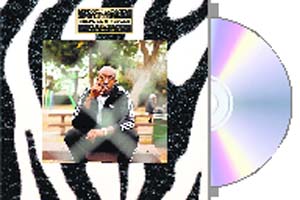 Pi`F1ata,
the fruit of Madlibís three-year collaboration with rapper Freddie
Gibbs, is one of the most refreshing, inventive hip-hop albums weíve
heard since Madlib and MF Doom teamed up a decade ago and released
arguably the best hip-hop album of its decade. The record carries the
producerís most appealing fingerprints: a knack for minimalist
funkiness and well-channeled quirks as well as some of his more
polished production, of late. Overall, however, itís a real hip-hop
album exhibiting the unparalleled technical ability and addictive
gravelly baritone weíve come to expect from Gibbs. Pi`F1ata
might be long, but it stirs fast. Gibbsí flow combined with the
gorgeous soul background of Deeper is nearly as breathtaking as
the story. Soul samples and jazz licks highlight the album, as Robes,
Knicks, and Shame linger around in listenersí heads long
after the next song plays. The real delicacies in the album are tracks
like Bomb and Uno, where beats are ostensibly retrieved
by one of Madlibís alter-egos. The albumís title track, which also
closes the LP, features a staggering six guest verses, and it works
superbly owing to the flow of young rappers like Casey Veggies, Domo
Genesis and Mac Miller that catapults Freddie Gibbs to mentor status.
The album showcases a definite chemistry between the rapper and
producer, each knowing when to lead and fall back. Pi`F1ata,
the fruit of Madlibís three-year collaboration with rapper Freddie
Gibbs, is one of the most refreshing, inventive hip-hop albums weíve
heard since Madlib and MF Doom teamed up a decade ago and released
arguably the best hip-hop album of its decade. The record carries the
producerís most appealing fingerprints: a knack for minimalist
funkiness and well-channeled quirks as well as some of his more
polished production, of late. Overall, however, itís a real hip-hop
album exhibiting the unparalleled technical ability and addictive
gravelly baritone weíve come to expect from Gibbs. Pi`F1ata
might be long, but it stirs fast. Gibbsí flow combined with the
gorgeous soul background of Deeper is nearly as breathtaking as
the story. Soul samples and jazz licks highlight the album, as Robes,
Knicks, and Shame linger around in listenersí heads long
after the next song plays. The real delicacies in the album are tracks
like Bomb and Uno, where beats are ostensibly retrieved
by one of Madlibís alter-egos. The albumís title track, which also
closes the LP, features a staggering six guest verses, and it works
superbly owing to the flow of young rappers like Casey Veggies, Domo
Genesis and Mac Miller that catapults Freddie Gibbs to mentor status.
The album showcases a definite chemistry between the rapper and
producer, each knowing when to lead and fall back.
Best track:
Uno
Worst track:
Lakers
Rating
**
An album of enriching
pop anthems,
all of equal rank
Future Islands ó
Singles (4AD)
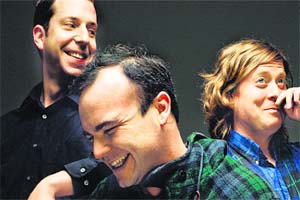  For Baltimoreís
synthpop-band Future Islands, itís been a long road, since their
formation in 2006, they have slowly built up, block by block, a solid
reputation. The bandís previous records were always interesting and
motivating. However, Singles has a strong sense of bold
confidence and character about it that makes it stand out. Herringís
melodramatic growl still forms the shape of the outfit, his voice
draped, as ever, in extensively moody and sentimental soundscapes.
Musically, the album sees the band sharpening up and refining their
sound until everything is positively gleaming. The collection is
filled with the sort of sounds that have rarely been heard since the
golden age of 1980s pop. The heart-rending lead single Seasons
opens the album and establishes the template, sonically and
thematically, for the rest of the LP. Elsewhere, with the sky-scraping
choruses and 1980s backdrops, Sun in the Morning and Doves form
the LPís more characteristically upbeat tracks, although Herring
still infuses his vocals with enough yearning to trigger a twinge of
sorrow. Closer Grease hits especially hard, sounding like an
ethereal funeral march, it fades out over somber strings and Herring
asking: "What happens to youth? / What happened to truth?" For Baltimoreís
synthpop-band Future Islands, itís been a long road, since their
formation in 2006, they have slowly built up, block by block, a solid
reputation. The bandís previous records were always interesting and
motivating. However, Singles has a strong sense of bold
confidence and character about it that makes it stand out. Herringís
melodramatic growl still forms the shape of the outfit, his voice
draped, as ever, in extensively moody and sentimental soundscapes.
Musically, the album sees the band sharpening up and refining their
sound until everything is positively gleaming. The collection is
filled with the sort of sounds that have rarely been heard since the
golden age of 1980s pop. The heart-rending lead single Seasons
opens the album and establishes the template, sonically and
thematically, for the rest of the LP. Elsewhere, with the sky-scraping
choruses and 1980s backdrops, Sun in the Morning and Doves form
the LPís more characteristically upbeat tracks, although Herring
still infuses his vocals with enough yearning to trigger a twinge of
sorrow. Closer Grease hits especially hard, sounding like an
ethereal funeral march, it fades out over somber strings and Herring
asking: "What happens to youth? / What happened to truth?"
Best track: Seasons
Worst track:
Back in the Tall Grass
Rating
***
Softer approaches and
contrasts make
for a thrilling ride
EMA ó The Futureís
Void (Matador)
 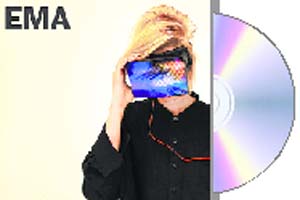 The Futureís Void
is not nearly as personal as EMAís debut, 2011ís Past Life
Martyred Saints. Itís a slicker, more professional, and more
abstract record that might put off any fans of her confessional work.
All throughout its nine tracks, there is a strong sense of sonic
identity and immense attention to detail; every sound and every effect
has a purpose. The album opens with Satellites, a pompous
industrial number that deals with draconian surveillance practices and
suggests that the real demons are manmade. Itís a boisterous opener,
and proves that Anderson has not only a fine grasp on the rhythm
section but is more than capable of phenomenal vocal delivery too. The
main lyrical focus of The Futureís Void is the disorienting
cyber-reality that often dominates our lives. Vibrant piano and
pensive, clean drums signify Andersonís plea for relief, a voice of
helplessness and estrangement on 3 Jane. Perhaps the most
effective track on the album is Neuromancer. Itís a clanking
tribal stomp that sees her evaluating the narcissism of modern age
where itís possible to "know more about the things that you
do". Cthuluís progressive vocal chants come to an explosive
climax with arresting synth beats and soaring guitars. The most
celestial moments on the album arrive at the end when Anderson loosens
her grip on her subject matter and letís herself wander a little. The Futureís Void
is not nearly as personal as EMAís debut, 2011ís Past Life
Martyred Saints. Itís a slicker, more professional, and more
abstract record that might put off any fans of her confessional work.
All throughout its nine tracks, there is a strong sense of sonic
identity and immense attention to detail; every sound and every effect
has a purpose. The album opens with Satellites, a pompous
industrial number that deals with draconian surveillance practices and
suggests that the real demons are manmade. Itís a boisterous opener,
and proves that Anderson has not only a fine grasp on the rhythm
section but is more than capable of phenomenal vocal delivery too. The
main lyrical focus of The Futureís Void is the disorienting
cyber-reality that often dominates our lives. Vibrant piano and
pensive, clean drums signify Andersonís plea for relief, a voice of
helplessness and estrangement on 3 Jane. Perhaps the most
effective track on the album is Neuromancer. Itís a clanking
tribal stomp that sees her evaluating the narcissism of modern age
where itís possible to "know more about the things that you
do". Cthuluís progressive vocal chants come to an explosive
climax with arresting synth beats and soaring guitars. The most
celestial moments on the album arrive at the end when Anderson loosens
her grip on her subject matter and letís herself wander a little.
Best track:
Satellites
Worst track:
So Blonde
Rating
***
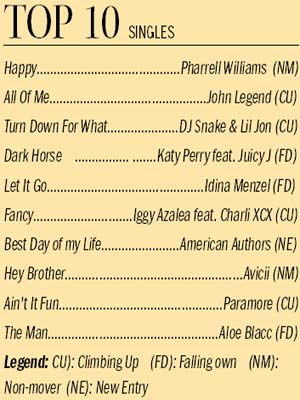
|